Intelligent and universal weather station
The very first building automation applications faced the challenge of capturing weather data and turning it into useful control commands. As a result, shades were often damaged by strong gusts of wind or closed in strong sunshine, even when there was no wind. The front controls could not cope with different levels of sunlight on the ground and upper floors. In this article, we will show how Theben KNX-based Meteodata weather stations are able to meet these requirements.
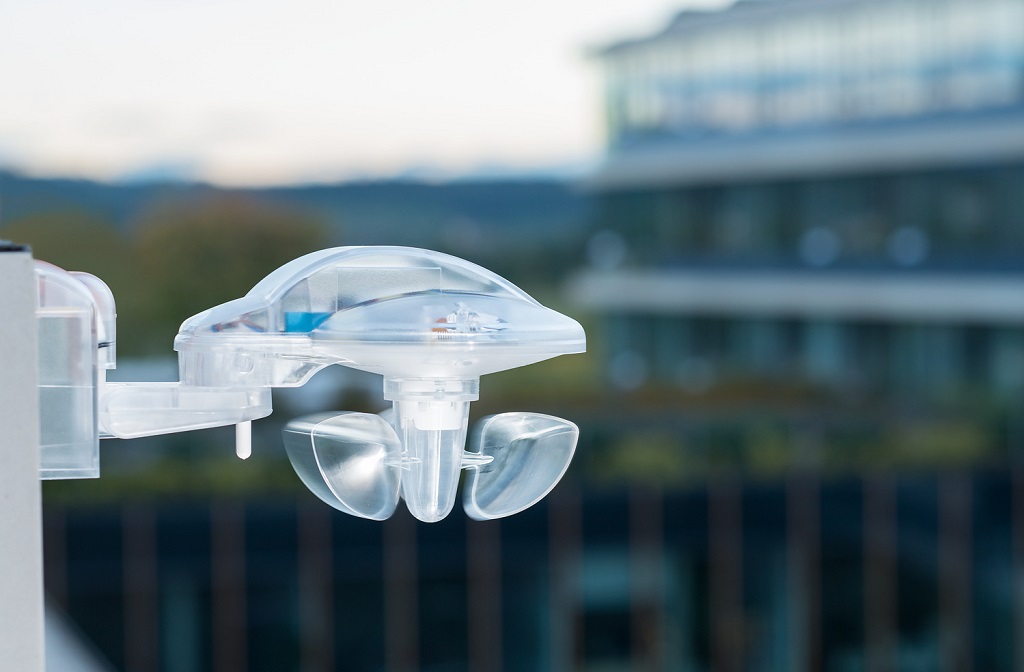
More reliable weather stations
Like most innovations, building automation is still a controversial topic. Like electromobility or decentralised energy production, it has a lot of potential. In practice, however, many designers and installers have been discouraged by negative experiences, such as when office blinds are lowered when they are not in direct sunlight, but the lights are switched on at the same time. Nor is it good for business if the blinds do not close back to a safe position in strong winds. This explains why investors prefer very simple and robust solutions to potential savings and greater convenience.
Building automation manufacturers have, however, gained a lot of experience in recent times, developing more reliable weather stations that, combined with the right software, provide cost-effectiveness and convenience of automation. Some classic problems and their solutions are presented below. This will enable the effective implementation of the knowledge gained, for example by using BIM (Building Information Management) in the design phase.
House with three southern facades
Typical examples of malfunctions are related to shading. The first professional meteorological stations operated with three sensors on the south, east and west facades, depending on the sun's path. This was based on the assumption that all the rooms behind the different facades were equally illuminated by the sun. However, this is only true for buildings with a few storeys that are completely separate. In taller buildings, however, the light conditions differ considerably between the ground floor and the upper floors, as the lower floors are often overshadowed by neighbouring buildings. As a result, shading functions correctly on the upper floors, but blinds are also activated on the lower floors, where the sun shines only moderately. At the same time, the artificial lighting is also activated, as the rooms on the lower floors are too dark and stressed employees prefer to switch off the automatic systems.These lighting conditions can be adapted to by dividing the façade into different units, which can be selected as required.
Up to 8 facade parts
Up to eight facade sections can be set up for Meteodata weather stations and programmed for different shading.What's more, a sun shaded area can be assigned to each facade (Figure 1). This feature takes into account that buildings are not evenly shaded from all sides by neighbouring houses. In many cases, sun shading is only required on a part of the facade in the morning or afternoon.Therefore, the control allows to define the position of the sun at which shading should be activated on each facade during the day (Figure 2). Areas that are already shaded by neighbouring buildings are not included. By freely combining the designated parts of the façade with the sun-shielded areas depending on the angle of the sun, each room can benefit from the maximum amount of natural light entering without glare.
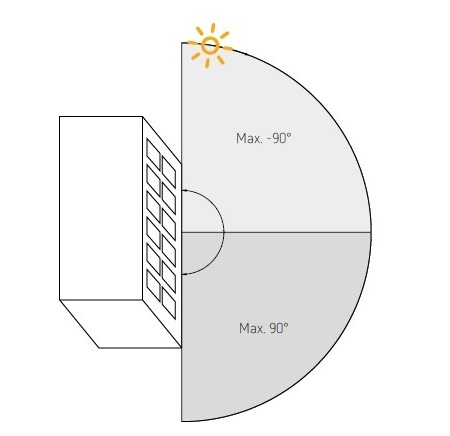
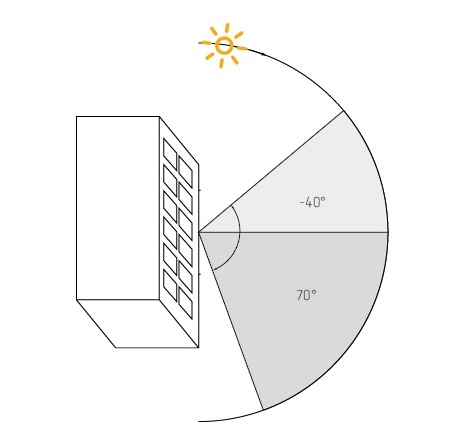
Perfectly controlled roller shutters
The method for detecting sunlight outlined above is only useful if the control takes into account the specific design of the sunscreen system. The simpler shading systems, predominantly used in residential areas, first lower the blinds completely when sunlight is detected and then adjust the louvres to a predetermined angle. A brightness sensor and, if necessary, timing and wind speed measurement are sufficient to control the shutters in the event of a storm. Such automation solutions are primarily designed to prevent overheating in empty rooms and are perfectly suited to this purpose.This is not the case in commercial properties, such as office buildings, where people need maximum light without irritating glare. This means that shading slats must be constantly adjusted (Figure 3). This sun position tracking function requires accurate data on the orientation of the facade, the position of the sun and the geometry of the blinds. The most advanced Meteodata weather stations are designed for this purpose and have a number of features that make installation much easier.
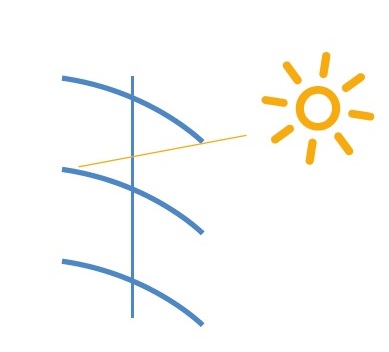
To calculate the exact direction of sunlight, the angular height of the sun above the horizon and the azimuth, the angle of the compass from which the sun shines, are used. Both values are closely related to the local time and date (Figure 4). In other words, if the Meteodata system knows the location and orientation of the building and the local time, it can calculate the direction from which the sun is shining on the facade. This information is easily available. Many systems already include a system clock, for example in the form of a web visualisation server. However, not all customers want or are able to provide a permanent internet connection.
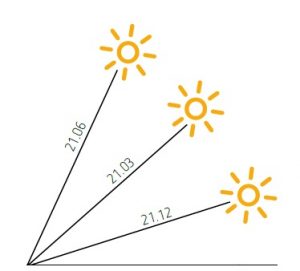
GPS modules
DCF77 radio clocks offer a self-sufficient alternative, as they theoretically have full reception throughout Europe. However, geographic location, for example south of the Alps, or an unfavourable location can interfere with reception. This is why some versions of the Meteodata series are equipped with GPS receivers. As the meteorological station is always outdoors, interference-free reception is virtually guaranteed. In addition, the module automatically gives the exact geographic position, making installation easy. The simpler versions offer the function of monitoring the position of the sun without a GPS module, where the position has to be entered manually and the system clock must be working. This is also possible for devices with a GPS module if, in exceptional cases, this data is not available for some reason.
In order to ensure that the roller shutter really does shade out direct sunlight, while still allowing maximum daylight to enter, the width and spacing of the shading slats must be taken into account in the calculation. Based on these data and the current position of the sun, the Meteodata weather station calculates the ideal position of the slats. As an alternative to the automatic calculation, predefined plate positions can be set for different sunlight positions. It may be necessary to fine-tune the position of the plates here during commissioning. However, this does not involve much effort as usually only one type of shutter is used on large facades. Finally, it is also worth mentioning that the operation of the shading system can be temporarily interrupted on individual facades. This may be necessary in case of strong winds, maintenance or cleaning.
There is no such thing as bad weather, just bad sensors
As well as the sun, rain is another weather phenomenon that building automation systems have to cope with. But when should a rain sensor react? Even during light drizzle, or only in continuous rain? It all depends on what the sensor needs to protect. First, the sensor cannot determine where the moisture is coming from. If you set it to the most sensitive setting, it will even detect morning dew. This can be useful when you need to protect textile blinds, which should only be stretched out when the humidity is already low enough. The rain sensor is equipped with an automatic heating system that is activated when humidity is detected. This means it detects the end of a downpour relatively quickly and reliably detects light drizzle. When the outside temperature falls below 5°C, the heating is switched on to avoid the rain sensor failing due to frost.
Data processing directly at the weather station
In addition to the usual universal channels (wind, temperature, brightness, etc.) and sunshade channels, Meteodata weather station also offers logic gates (AND, OR, NOT). These can be used to create simple algorithms taking into account all internal and external conditions.
Combined with the actuators of the Theben shutter, the Meteodata weather station gives you the maximum. For example, it is possible to automatically activate the shading of a room only when the outside temperature exceeds 15°C and there is someone in the room. If the room is empty and the sun is not disturbing anyone, the sunlight is used to heat the room. And vice versa, in summer you can shade the meeting room when it is not in use to make it as cool as possible. This can also be combined with other features such as lighting.
The right station for every application
Meteodata devices are intended for use in KNX systems and are available in various configurations. In addition, there is a version for the LUXORliving smart home system, based on KNX components with reduced functionality, allowing relatively simple and cost-effective automation of residential buildings without ETS. The stations are available with or without a GPS module and with different power supply options (via KNX only, 24 V, 230 V). The 24 V and 230 V versions operate continuously, even without the additional power supply. However, the rain sensor heating and GPS functions are not available.
Mechanical structure of the Meteodata meteorological station
The mechanical design and sensor quality of the Meteodata meteorological station has been designed over a long period of time to ensure high measurement accuracy. Theben has not opted for the cheaper but inaccurate measurement method based on wind speed and temperature differences, but the Meteodata weather station is equipped with a professional anemometer (wind gauge) that allows the control to reliably respect the wind thresholds specified by the shade manufacturers. The rotor is placed at the bottom of the housing, protected from frost and dirt, and the other sensors are carefully positioned. The temperature sensor, for example, extends out of the housing so that it is not affected by the heating of the rain sensor. The transparent enclosure picks up the colour of the façade to blend in with the overall appearance of the building (Figure 5). Made of extremely strong plastic, it is resistant to cold, heat and solar radiation. All components are UV protected, making the weather station extremely durable. It combines all the sensors needed for building automation in a single housing. Measurement accuracy fully meets the increased requirements of modern energy use, comfort and automation in both residential and commercial buildings.
